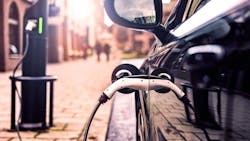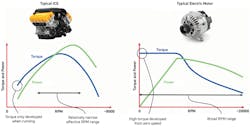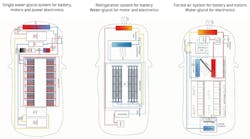Lubrication and Tribology Trends (and Challenges) in EVs
The automotive industry is going through a slow change as manufacturers and consumers are being pushed to build and buy more electrically powered cars and trucks. Emission regulations are prompting car builders to turn out more electric vehicles, including hybrids. At the same time, high-gas prices and appeals for a cleaner environment are convincing many buyers to trade in their internal combustion engine (ICE)-powered rides for electrical alternatives. But for EVs to truly succeed, it is likely advances need to be made in lubricants and other areas of tribology. (Tribology is the study of three topics—friction, wear and lubrication—and their interactions in sliding surfaces.)
EVs are Not ICEs
What differentiates ICE vehicles from EVs are the drivetrains. EVs have batteries and a motor, while ICE vehicles have a gas tank and engine. There still share many common elements such as the bodies, interior, headlights and other accessories, as well as tires. However, when it comes to tires, some auto experts recommend different tires for EVs. They should have tread patterns that improve mileage to combat EVs’ current lack of range and be quieter on the road, because there is no engine noise to drown out the noise of normal tires when rolling at high speeds. The heavier weight or mass of an EV (due to the batteries needed) puts more strain on the tires, so they also need stronger sidewalls to cope with it.
EVs need lubrication for friction reduction more than ICEs because lower friction means more mileage and, as said before, today’s EVs are lacking in the mileage department. And EV lubrication is important for transferring torque rather than load carrying, a major change from ICE vehicles.
EV Driveline Challenges
Electric motors have very different torque and power curves. “An ICE needs to be running to develop power and torque,” says Martin Webster, a senior research associate at ExxonMobil and past president of the Society of Tribologists and Lubrication Engineers. “In an ICE powertrain, a clutch is needed to decouple the engine from the gearbox so power can be transferred when the vehicle is not moving. In contrast, an EV develops torque right from the start, and it can provide power over a relatively wide speed range. So, it delivers power differently.”
ICE transmissions have gained more gear ratios as time goes on. That’s because auto engineers always want to increase energy efficiency. But the range of different gear ratios limits the range of input shaft speed. “While an ICE gearbox can look complicated, the lubrication challenge may not be as challenging as in typical EVs,” says Webster.
In single ratio EV drives, it is not easy to balance input and output shaft lubrication requirements for the individual bearings and gears. The bigger speed difference and single ratio results in a much broader range of operating conditions in EVs than in traditional gearboxes. And EVs can generate high torque levels from start up through low rpms. This places a severe load on the lubricated contacts before they develop thick lubricating films, which they eventually do at higher speeds.
EVs might require new gear oil additives and tests for measuring wear protection under EVs’ high-load/lower-temperature operating conditions. It is likely the new gear tests and standards will also need to be developed.
“We are getting a much better understanding of how additive films are created and how they respond to the operating environment,” Webster says.
This will provide opportunities to apply recent advances in developing the next-generation of EV lubricants. The goals for these driveline lubricants will be to improve gear efficiency and performance, lower operating temperatures and extend the driving range possible on a single charge (which, again, is crucial to consumers).
There must be advancements or trade-offs will need to be made. Moving to a lower viscosity reduces churning and pumping losses, increasing efficiency. Gearbox churning losses are typically reduced with lower viscosity lubricants. However, in some cases churning losses increase as viscosity is lowered. And at high speed, churning losses seem to more sensitive to design and fluid properties.
Currently the most common option is to use high-performance synthetic gear oils; there also is the potential to reduce friction further using new fluid technology. “Understanding lubricant flow in gearboxes is going to be important in developing drives with minimal friction,” Webster says.
Thermal Management
Many components, including the battery, electronics and motor, require active thermal management for the following reasons:
“The cooling strategy is different between OEMs when it comes to EVs, but the challenge is the same,” Webster explains. “There needs to be thermal management of all the systems. For the coolant, pumping losses have become a huge issue and are driving the need to lower viscosity fluids.
“Thermal management is evolving as a core area of interest to EV designers,” he continues. “It includes heating as well as cooling. An example is warming at startup to get a reasonable battery output; at the other end, if you exceed a certain temperature, you can permanently hurt the battery.”
Power electronics heat up quickly. The EV motor is efficient, but it still generates heat. It can permanently damage the battery and motor, requiring replacement of the motor. Making the motor more efficient by using better lubricants would reduce this risk. Another approach it to cool the motor and batteries.
There are several approaches to cooling EV components:
- Single water-glycol cooling subsystem for the battery, motors and power electronics.
- Refrigeration for the battery and water-glycol cooling for the motor and electronics.
- Forced air for the battery and motors; water-glycol for electronics.
One set of problems for lubricants used in these cooling subsystems is oil flow and air entrainment at higher speeds. Extreme air entrainment conditions may lower cooling efficiency and introduce foaming problems. One way to examine these interrelated issues is to devise better simulation models that help engineers understand the interactions between the mechanical design, lubricants and subsystem performance.
Combining lubrication and thermal performance is a major challenge. Efficient cooling requires a specific combination of fluid properties: high-density, high-thermal conductivity, in addition to high-specific heat capacity and low-dynamic viscosity. Improving heat transfer also affects other physical properties such as flash point and volatility, major considerations for low-viscosity fluids. Mainstream hydrocarbons exhibit a limited range of thermal properties.
“Lubrication and cooling are a little antagonistic,” Webster says. “Water is a good coolant but, generally speaking, it is not a good lubricant. One approach engineers have been exploring is whether it’s possible to use hydrocarbons differently, with direct contact rather than having an interface.”
For EVs to thrive and succeed, tribologists need to make advancements in several areas including: component design and materials; drivelines and gear oils; lubricant coolants and other fluids, and bearings and greases.
“After 30 years of development, wind turbines still have problems with tribology issues, says Webster. “Maybe we can be a bit more proactive with EVs than we were with wind turbines. As it was one time with wind turbines, EVs are at the beginning of an evolving technology.”
Editor’s Note: A version of this article first appeared in Tribology & Lubrication Technology, the monthly magazine of the Society of Tribologists and Lubrication Engineers, an international, non-profit professional society headquartered in Park Ridge, Ill.
Jeanna Van Rensselar heads her own communication/public relations firm, Smart PR Communications, in Naperville, Ill. You can reach her at [email protected].





